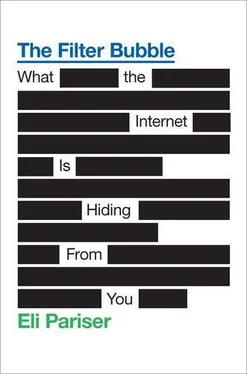26 surprised to find them at the top:Ibid., 27.
26 Random House, controlled only 10 percent:Ibid., 25.
26 so many of them—3 million active titles:Ibid., 25.
27 They called their field “cybernetics”:Barnabas D. Johnson, “Cybernetics of Society,” The Jurlandia Institute, accessed Jan. 30, 2011, www.jurlandia.org/cybsoc.htm.
27 PARC was known for:Michael Singer, “Google Gobbles Up Outride,” InternetNews.com, Sept. 21, 2001, accessed Dec. 10, 2010, www.internetnews.com/bus-news/article.php/889381/Google-Gobbles-Up-Outride.html.
27 collaborative filtering:Moya K. Mason, “Short History of Collaborative Filtering,” accessed Dec. 10, 2010, www.moyak.com/papers/collaborative-filtering.html.
28 “handle any incoming stream of electronic documents”:David Goldberg, David Nichols, Brian M. Oki, and Douglas Terry, “Using Collaborative Filtering to Weave an Information Tapestry,” Communications of the ACM 35 (1992), 12:61.
28 “sends replies as necessary”:Upendra Shardanand, “Social Information Filtering for Music Recommendation” (graduate diss., Massachusetts Institute of Technology, 1994).
29 fewer health books:Martin Kaste, “Is Your E-Book Reading Up On You?,” NPR.org, Dec. 15, 2010, accessed Feb. 8, 2010, www.npr.org/2010/12/15/132058735/is-your-e-book-reading-up-on-you.
30 as if by an “objective” recommendation:Aaron Shepard, Aiming at Amazon: The NEW Business of Self Publishing, Or How to Publish Your Books with Print on Demand and Online Book Marketing (Friday Harbor, WA: Shepard Publications, 2006), 127.
30 “notion of ‘relevant’”:Sergey Brin and Lawrence Page, “The Anatomy of a Large-Scale Hypertextual Web Search Engine,” Section 1.3.1.
31 “advertising causes enough mixed incentives”:Ibid., Section 8, Appendix A.
32 “very difficult to get this data”:Ibid., Section 1.3.2.
33 black-ops kind of feel:Saul Hansell, “Google Keeps Tweaking Its Search Engine,” New York Times , June 3, 2007, accessed Feb. 7, 2011, www.nytimes.com/2007/06/03/business/yourmoney/03google.html?_r=1.
33 “give back exactly what you want”:David A. Vise and Mark Malseed, The Google Story (New York: Bantam Dell, 2005), 289.
34 “ancient shark teeth”:Patent full text, accessed Dec. 10, 2010, http://patft.uspto.gov/netacgi/nph-Parser?Sect1=PTO2&Sect2=HITOFF&u=%2Fnetahtml%2FPTO%2Fsearch-adv.htm&r=1&p=1&f=G&l=50&d=PTXT&S1=7,451,130.PN.&OS=pn/7,451,130&RS=PN/7,451,13.
35 “could call that artificial intelligence”:Lawrence Page, Google Zeitgeist Europe Conference, May 2006.
35 “answer a more hypothetical question”:BBC News, “Hyper-personal Search ‘Possible,’” June 20, 2007, accessed Dec. 10, 2010, http://news.bbc.co.uk/2/hi/technology/6221256.stm.
36 “We’re a utility”:David Kirkpatrick, “Facebook Effect,” New York Times, June 8, 2010, accessed Dec. 10, 2010, www.nytimes.com/2010/06/08/books/excerpt-facebook-effect.html?pagewanted=1.
37 “more news in a single day”:Ellen McGirt, “Hacker. Dropout. CEO,” Fast Company, May 1, 2007, accessed Feb. 7, 2011, http://www.fastcompany.com/magazine/115/open_features-hacker-dropout-ceo.html.
37 it rests on three factors:Jason Kincaid, “EdgeRank: The Secret Sauce That Makes Facebook’s News Feed Tick,” TechCrunch blog, Apr. 22, 2010, accessed Dec. 10, 2010, http://techcrunch.com/2010/04/22/facebook-edgerank.
38 the 300 million user mark:Mark Zuckerberg, “300 Million and On,” Facebook blog, Sept. 15, 2009, accessed Dec. 10, 2010, http://blog.facebook.com/blog.php?post=136782277130.
38 the Washington Post homepage:Full disclosure: In the spring of 2010, I briefly consulted with the Post about its online communities and Web presence.
39 “the most transformative thing”:Caroline McCarthy, “Facebook F8: One Graph to Rule Them All,” CNET News , Apr. 21, 2010, accessed Dec. 10, 2010, http://news.cnet.com/8301-13577_3-20003053-36.html.
39 sharing 25 billion items a month:M. G. Siegler, “Facebook: We’ll Serve 1 Billion Likes on the Web in Just 24 Hours,” TechCrunch blog, Apr. 21, 2010, accessed Dec. 10, 2010, http://techcrunch.com/2010/04/21/facebook-like-button.
42 Acxiom knew more:Richard Behar, “Never Heard of Acxiom? Chances Are It’s Heard of You,” Fortune, Feb. 23, 2004, accessed Dec. 10, 2010, http://money.cnn.com/magazines/fortune/fortune_archive/2004/02/23/362182/index.htm.
43 serves most of the largest companies in America:nternetNews.com Staff, “Acxiom Hacked, Customer Information Exposed,” InternetNews .com, Aug. 8, 2003, accessed Dec. 10, 2010, www.esecurityplanet.com/trends/article.php/2246461/Acxiom-Hacked-Customer-Information-Exposed.htm.
43 “product we make is data”:Behar, “Never Heard of Acxiom?”
44 auctions it off to the company with the highest bid:Stephanie Clifford, “Your Online Clicks Have Value, for Someone Who Has Something to Sell,” New York Times, Mar. 25, 2009, accessed Dec. 10, 2010, www.nytimes.com/2009/03/26/business/media/26adco.html?_r=2.
44 takes under a second:The Center for Digital Democracy, U.S. Public Interest Research Group, and the World Privacy Forum’s complaint to the Federal Trade Commission, Apr. 8, 2010, accessed Dec. 10, 2010, http://democraticmedia.org/real-time-targeting.
44 leave without buying anything:Press release, FetchBack Inc., Apr. 13, 2010, accessed Dec. 10, 2010, www.fetchback.com/press_041310.html.
45 “62 billion real-time attributes a year”:Center for Digital Democracy, U.S. PIRG, and the World Privacy Forum’s complaint.
45 the Rubicon Project:Ibid.
Chapter Two: The User Is the Content
47 “undermines the democratic way of life”:John Dewey, Essays, Reviews, and Miscellany, 1939–1941, The Later Works of John Dewey, 1925–1953 , vol.14 (Carbondale: Southern Illinois University Press, 1998), 227.
47 “been tailored for them”:Holman W. Jenkins Jr., “Google and the Search for the Future,” Wall Street Journal, Aug. 14, 2010, accessed Dec. 11, 2010, http://online.wsj.com/article/SB10001424052748704901104575423294099527212.html.
48 “don’t know which half”:John Wanamaker, U.S. department store merchant, as quoted in Marilyn Ross and Sue Collier, The Complete Guide to Self-Publishing (Cincinnati: Writer’s Digest Books, 2010), 344.
49 One executive in the marketing session:I wasn’t able to identify him in my notes.
49 Now, in 2010, they only received:Interactive Advertising Bureau PowerPoint, report, “Brand Advertising Online and The Next Wave of M&A,” Feb. 2010.
50 target premium audiences in “other, cheaper places”:Ibid. 50 “denied an assured access to the facts”:Walter Lippmann, Liberty and the News (Princeton: Princeton University Press, 1920), 6.
50 blogs remain incredibly reliant on them:Pew Research Center, “How Blogs and Social Media Agendas Relate and Differ from the Traditional Press,” May 23, 2010, accessed Dec. 11, 2010, www.journalism.org/node/20621.
Читать дальше











